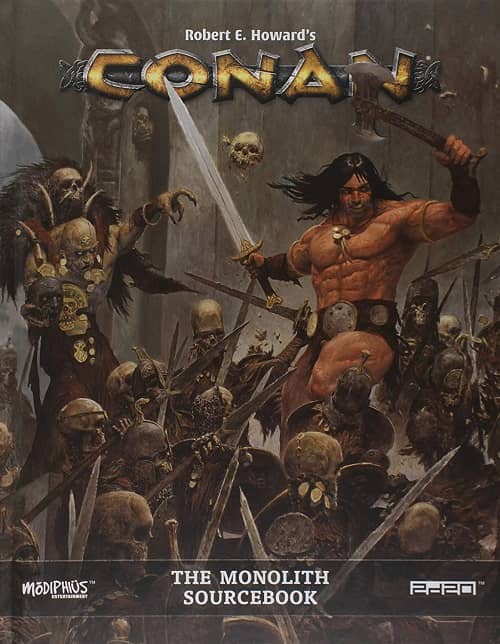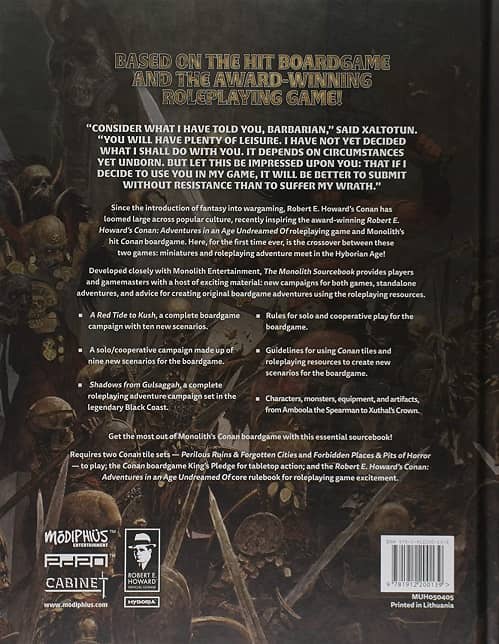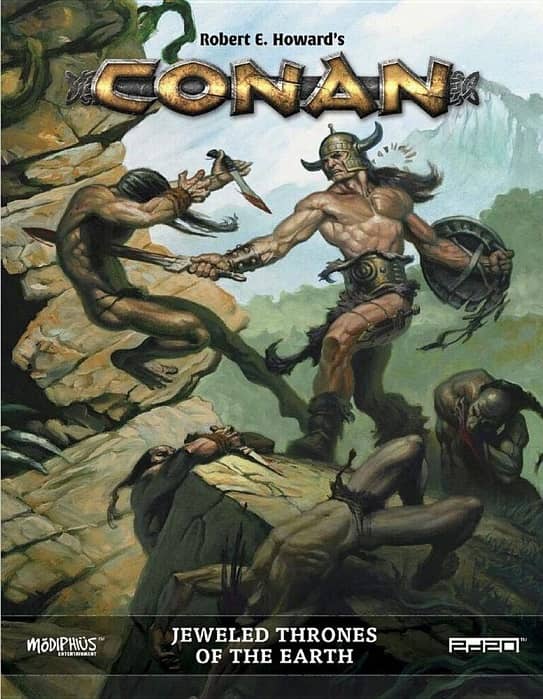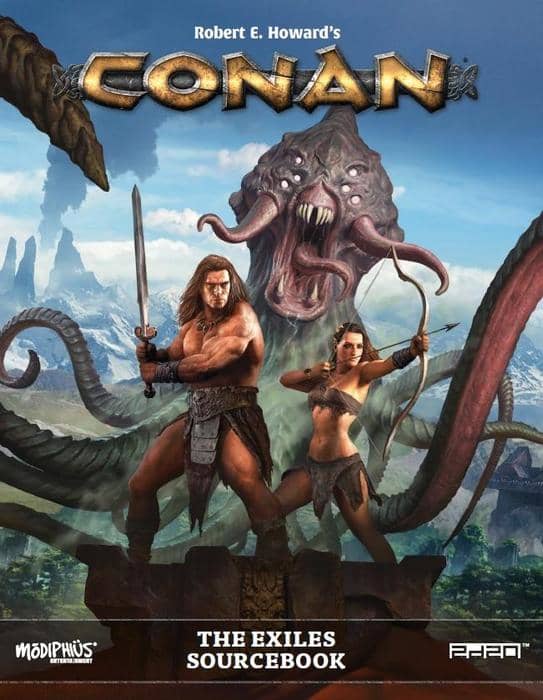A Report on Modiphius’s Robert E. Howard’s Conan: Adventures in an Age Undreamed Of—Part Three
 |
 |
In the previous two articles in this series (Part I and Part II), I have explained Conan 2d20’s core mechanic, character structure, and combat. I believe that this is what is required to begin to “grok” the principles of this game. For the concluding installment in this discussion, therefore, I will address criticisms, provide “mini-reviews” of the various Conan 2d20 supplements, and point to the overall Conan gaming community.
My online Conan group initially formed around me as GM. I ran two adventures over five sessions. Currently someone else is GMing and is soon to pass the “story stick” to someone else. This method of shared GMing, I believe, is representative of Robert E. Howard’s source material: episodic, (in our case) “main characters” come and go.
The current GM once gave to me what I think are accurate estimations of Conan 2d20 overall. He gives the artifact of the game (beautiful, full-color art throughout, well-bound, a place-ribbon included in every volume) and the system itself an “A.” Rules presentation he awards a “C.” He says, when he recommends Conan 2d20 to prospective gamers, he feels like he is recommending a friend who he knows is lazy to a job interview.
The laziness, perhaps, results from rules presentation. The book forces quite a bit of cross-referencing to figure out some of the particular action resolutions. Moreover, the reader must learn that some terms, which may at first appear to be synonyms of each other, likely have particular meanings in terms of game mechanics. This confusion is mitigated only partially by the use of capitals to denote particular mechanical functions. A lot of the rules, unfortunately not always expressly stated as such, must read as logical propositions, i.e., “if A and B, then C.” And this sort of reasoning delightfully spills out into the forums. Also on the forums are outright new rules constructions and innovations, usually to fill in what has inadvertently or by design been left out of the book. To be clear, the rulebook often states its ethos as being a flexible system wide open to GM rulings, but this assertion is compromised by the presence of Skill Talent trees: it is not unlikely that a chance GM ruling or group consensus, which may result in a campaign precedent, will “invade” a feature conferred by a Talent, which consequently invalidates the worth and usefulness of that Talent. With this measure of ambiguity, Conan 2d20 rules lawyers are likely to find many opportunities to bring suits to court.
As of this writing, Modiphius has completed (at least all the PDF productions) its obligations resulting from its hugely successful Kickstarter that initially funded this project. As a late backer, I went in for a hardcover copy of the Core Rule Book and every item resulting from the Kickstarter in PDF. As I have grown more attached to this game — indeed, I think it is the high water mark of RPG design and gameplay — I have found the collector in me acquiring every book in this series (and then some, which I shall explain below) in physical form. Here I will give my critical impressions on them.
Before doing so, however, I feel obligated to remind everyone that “mileage varies.” I have particular “needs” from my rpg resources that cause me to undervalue what may be essential to other gamers. This perspective will be made apparent in these “mini reviews.”
Player’s Guide. A number of people have complained that this doesn’t contain rules for Sorcery (and some PCs — not all — aspire to become sorcerers). It also lacks a few items from the Equipment lists — vehicles, specifically — and some player-specific information regarding Downtime and Carousing. This last requires some explanation: Between every episodic adventure are some procedures for character maintenance and development. The absence of that information in the Player’s Guide is notable. Still, the book is of some use and inexpensive enough that I have two at my table.
Conan GM Screen & Toolkit. I don’t own this in physical form, but, though the screen may be sturdy and beautiful, after a few sessions of GMing you might as well hand it over to the players for their own reference. This is because most of the information on here is fairly easy to remember. For whatever reason, the features that are not easily memorizable have been left out. It seems that Modiphius tried to mitigate this apparent oversight with a small pamphlet that contains one of the useful items — Weapon Stats and Qualities — but, in the end, I had to construct my own GM screen that includes character Skills (so I can easily determine what a character needs to use for a test) and short rules explanations of character tactical Actions.
The Toolkit, in contrast, is invaluable for GMs who are constructing their own adventures. The Core Book provides a lengthy and detailed discussion about what entails a satisfying Robert E. Howard Conan tale and how to translate that understanding into gaming, but the Toolkit builds on this with adventure generation tables. Truthfully, these charts, in appearance, are not much different from many “system agnostic” generators, but there is some ineffable quality in them that, for me, results in slightly cooler results and a tone that is just so Conan. This is “essential.”
Jeweled Thrones of the Earth. This is a collection of adventures. I tend to construct my own adventures, so I’m not the right person to speak about the quality of these. I’ve read them all, and they seem quite entertaining, though I don’t feel compelled to try running any of them. They are information-dense, and many of them seem “railroady.”
Conan the Barbarian. Because I’m an enthusiast of all things “northern,” naturally I immediately ordered this for my shelf. My interest in this book is admittedly particular. I enjoy how the writers present “northern culture” while simultaneously “Weirding” it for the Hyborian Age.
Conan the Thief. I consider this to be an “essential” supplement. It contains tables for a “Heist Generator.” Very cool and inspirational.
Conan the Mercenary. Another “essential” supplement, since it contains rules for larger-scale combat.
The Book of Skelos. Many in the Conan 2d20 community list this as an “essential” supplement, though I’m not certain. It contains rules for “faction” and “cabal” play, but those rules are confusing. Moreover, many believe that the additions to Sorcery, in this book, further confuse the oftentimes already puzzling rules from the Core Book.
Conan the Pirate. An “essential” supplement, because it contains rules regarding water vessels and ship combat.
Horrors of the Hyborian Age. This is a monster book, which feels sort of superfluous for a game whose tone is so anthropocentric. Anyway, it’s unnecessary, since every supplement contains a sampling of Fearsome Foes. Moreover, the competent GM has everything she needs in the Core Book alone to make up whatever creatures and abilities are required, even on the fly.
Conan the Brigand. An “unnecessary” supplement, though it contains cool Loot and Trade Goods tables.
Nameless Cults. An “unnecessary” supplement for anyone well-versed in the source fictions or is comfortable working with belief analogues from “real world” history.
Ancient Ruins & Cursed Cities. An “unnecessary” supplement, considering how seldom “dungeon adventures” are going to occur in this game, though the tables for generating such features are awesome.
Conan the Wanderer. Unnecessary.
Conan the Adventurer. Unnecessary.
Conan the Scout. Unnecessary.
Conan the King. “Necessary.” This one contains rules supporting court intrigue and nations at war.
Kull of Atlantis. Mechanically, some material here overlaps with content in King, but, for me, this resource nonetheless is “essential” because it overviews the Thurian Age. There’s something about its art style, too: it’s so evocative and somehow different from the Conan books.
The Monolith Sourcebook. This book leads to a little discussion about how Conan 2d20 is just one part of an entire spectrum/community of Conan gaming. About the same time that Modiphius was getting going on its rpg, Monolith was likewise funding a tactical board game. What is amazing is how much consonance the two games have. Both games use Zones for tactical combat, so the Monolith boards can be used with Conan 2d20, and the Conan 2d20 map tiles can be used in new scenario creation for the Monolith game. This sourcebook serves as something of a bridge, presenting content for both systems, as well as rules for Solo play within the Monolith system. The solo campaign provided herein requires (in addition to the Monolith “King” pledge) Modiphius’s tile sets Forbidden Places & Pits of Horror and Perilous Ruins & Forgotten Cities. Other tile sets that Modiphius has published are Dens of Iniquity & Streets of Terror and Fields of Glory & Thrilling Encounters. I should add, specifically as one in the role of an rpg gamer, that these tile sets are unnecessary, perhaps even distracting. One of the most liberating aspects of this system is the ease with which the GM simply can sketch a few shapes onto a sheet of scratch paper, perhaps even color in a feature or two or three, at any moment in which a tactical encounter is initiated. Of course, one can even do this with the Monolith board game, but this is kind of anathema to board game culture, right? Anyway, any Conan 2d20 game spontaneously can result in a satisfying tactical encounter, and the Monolith Conan rules can be used for an improvisational skirmish war game.
I also should point out that this Conan gaming community extends beyond these two companies. Recently a small game detailing “The Tower of the Elephant” successfully funded, and some stretch goals included within that campaign provided complimentary copies of the Conan 2d20 core rules. The Conan gaming community includes the video games, too, both Age of Conan and Conan Exiles (the latter of which also has a sourcebook with Modiphius, one detailing exploration and survival in a Conan setting). Three of my current gamers (of five) are playing 2d20 because of free PDFs of the game they received with their video game purchases. You hear that, Modiphius? That strategy paid off!
I will conclude by saying that Conan 2d20 has forever changed RPGs for me. I read and play a lot of games, but, now, being conversant with 2d20, it’s difficult to countenance many other methods of action resolution. For me, this system is the industry standard in terms of speed and flexibility while maintaining simulationist detail. For anyone whose interest extends beyond this specific Conan property to the 2d20 system itself, it should be noted that Modiphius’s house system, for every IP it contracts, gets torn apart then entirely rebuilt in service to emulating the specific acquisitions in question. Some other properties have been John Carter of Mars, Star Trek Adventures, and (forthcoming) Dune. None of these games — though 2d20 systems — play exactly the same as the others. This certainly creates some impediments to game system migration — and this might be one reason why so many are hoping for a genre-neutral rules set tentatively titled the Momentum system — but mostly people want a core primer with which to construct their own systems and genre emulations.


I say this as somebody who hasn’t actually played the system — just watched various YouTube reviews, actual plays, etc. — but I think the hardest part to deal with at the table would be the way they handle damage on a D6. Hence, I suppose, the custom dice, which I hope will be back in stock at some point.
I also really hope we’ll get a physical edition of the Kull book sooner or later.
Thank you for taking the time to give us such an in-depth look at this game. I hope Modiphius appreciates it.
I’ve been trying to resist diving into this game due to budget and space constraints, but you’ve made it REALLY tempting. I think I’ll take the plunge if they ever come out with a physical edition of that Kull book.
Thanks again!
I can’t help but feel you’re being a little harsh on some of those supplements. Brigand has a really cool mechanic both for building a band of brigands and maintaining a stronghold and for getting them (or your group) across the lands of other unseen. That’s a memorable campaign, right there and VERY Conan.
I know that you mentioned your reviews are in the light of specific needs that your campaign has and that’s fair enough. But readers might like to know more about the Adventurer supplement, which is too big and too awesome for me to do justice here, but it is a beautiful example of taking Howards’ less than PC writings and creating a culturally sensitive, playable, unique setting. Africa has NEVER been done like this in RPGs!
First of all, thank you for reading, Bastenfyre, and thank you for recognizing how I have framed my criticism. Not all of my critics of my criticism have been as candid a reader as you have been.
To reiterate, Conan 2d20 remains my most favorite game, both to run and play. My online campaign of multiple GMs continues, with no indication of abating. I own every supplement in hardcover, as well as the entire existing line in PDFs. Despite the many problems with the line, I hope it continues.
But let’s go ahead and talk about Conan the Brigand. I know the mechanic of which you speak. I believe it is called Influence, and perhaps you can explain it to me. How does one determine the Influence of any given character? The rules suggest that Renown might have something to do with it (it adds to it?), but, again, we’re looking at characters having at least 5+ (and more than 10, because if you win a competition for Influence, you gain ten, and, if you lose, you lose ten). Also, if you lead a bunch of other characters, you get their Influence, too, so…
Mind you, I’m not criticizing the mechanic. I think it’s a great idea. But, as presented, it’s simply an idea. Too many of these sourcebooks–the vast majority of them–remain a collection of unformed ideas for the GM to do with as she wants. And that’s fine. But I believe my point has to be recognized that these books are imperfect–at least they are “incomplete.”
As far as sources of lore and evocation, I love them. That’s why I continue to buy them and read them and (try to) find ways to use them in my game. But I don’t think this means that I have to unequivocally endorse them. The sourcebooks, even in hard copy, are inexpensive enough that they continue to provide value, even if a GM does not need setting materials. Perhaps it is worth it, yet I have deemed them “unnecessary.”
The following here will go well beyond your comment, Bastenfyre, but, I believe that, for posterity, anyone who continues to find their way here and is rankled by my criticism might like to know that I have shared this “explanation” (and the latent “review/criticism” here in this last installment) with the Conan Gaming Group over at Facebook. Many enthusiasts there–including two designers and writers who worked on the supplementary line–agree with you that I have been too “harsh” in judgments here. In particular, it was suggested that I should have used the word “non-essential” rather than “unnecessary,” because (as they reasoned) “unnecessary” suggests that there was no reason to write such a book, whereas “non-essential” suggests (at least to the designers) that it isn’t required for play. To me, this is a semantic quibble. Of course the books aren’t required for play. They’re sourcebooks.
Yet I recognize that anyone who sets themselves up to “evaluate” any other writer’s work is inviting a reaction or criticism against that criticism. And I respect this. I accept and welcome it. However, too often these days I feel that the “criticism” levelled back against me is a condemnation of my “negativity.” (Again, this is outside of the concerns raised by your own comment, Bastenfyre; this is for posterity alone, because it appears that these postings continue to get read now and then. And I probably, in no small part, have Bob Byrne to thank for that! ;)) The sense I get is that an enthusiast is expected to enjoy a product or line unequivocally. If one has any concerns, it is best to keep silent, because, well, a lot of people “worked hard on this.” (Yes, this is most often the answer I get back.)
And that’s fine. But I do have to wonder: If you truly do value this product, and if you truly worked hard on this, how do you account for all of these errors and unformed ideas? And they don’t.
Despite how much I love and will continue to support this line, the latent attitude I seem to be receiving from Modiphius in regards to their lack of quality sounds like this: “Our Kickstarter promised a book; we made a book. What more do you want?”
I want something that reflects a little more care and commitment.